Lawn
What does it take to have a greener, thicker and healthier lawn? It takes a lot of hard work and a great monthly treatment plan. There are many things that can and will prevent you from having a healthy lawn. Here are a few examples of problems that may affect your lawn at one time or another.
Insects
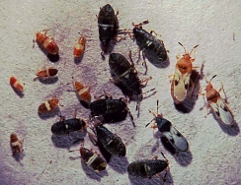
|
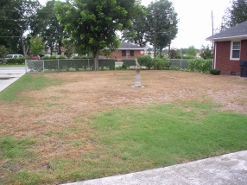
|
Chinch Bugs can damage your lawn extensively in a very short amount of time. For this reason, they need to be treated as soon as the damage is evident, or you risk losing your entire lawn. Female Chinch Bugs can lay up to 5 eggs a day, and with a 2 month lifespan that’s up to 300 eggs per female. Chinch Bugs damage the grass by feeding on the plant fluids found circulating inside the grass structure. Chinch Bugs inject phytotoxic saliva as part of the feeding process and as a result, this causes the grass to die.
Moles can also affect the appearance of your lawn. When moles tunnel through your lawn, they are ripping apart the root structure of your grass with every tunnel they make. This in turn causes the grass to die in the areas where the tunneling is severe. Contact us today to learn about a new method of eliminating moles.
Ants, not only will they hurt you, but also your lawn. Fire ants in particular make very large mounds throughout your lawn. These mounds tend to kill the grass they are built on top of. Large Fire ant mounds are also very visible and take away from the appeal of your lawn.
Sod Web Worms are mostly seen during the fall season. Have you ever noticed white moths flying up out of your grass as you walk across it?
Those are the fully matured adult sod webworms. With every flight they are laying more eggs in your lawn. These eggs turn into the larval sod webworm that does the actual damage. A single larval sod webworm can eat up to 4 square feet of grass.
Drought and Freeze Damage
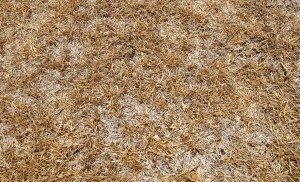
|
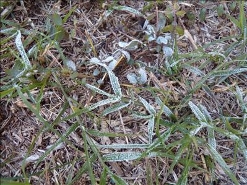
|
There are different times of the year when your lawn is susceptible to Drought or Freeze damage. As shown above, grass can dry out and die during times of Drought due to extreme heat and evaporation. Drought damage, when left unchecked will eventually kill the grass. First in areas with no shade and very little watering. Broken or mis-aligned sprinklers can make things even worse. Grass will turn yellow and finally brown when dead. Does your grass make crunching sounds when walked on? Are the grass blades rolled up like straw? Is the soil powder dry? These are all signs of drought damage and the need for more water.
During winter time, it is important to water your lawn after a freeze, as freezes typically dry out the lawn. If you wake up to find that your lawn is covered in frost, do not walk on it. Doing so will cause damage to the grass and make it harder for it to bounce back once the cold weather is over.
Dead grass, whether from drought or freeze, takes a long time to fill back in. Very small areas may fill in by themselves. Slightly larger patches of dead grass can often be replaced using plugs. First though, the dead grass needs to be raked out. Then top soil should be applied when planting the plug in order to give it room for the runners to grow out. Very large areas of dead grass will need to be re-sodded. Left alone, large barren areas will quickly fill in with weeds.
Moisture Control
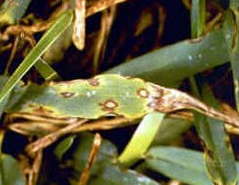
|
Your lawn needs water to survive, however too much watering can create Fungus in your Lawn. Fungus can take on many different appearances depending on the type of fungus. Gray Leaf Spot can make your grass look withered and dieing. In areas of shade the fungus will appear worse due to the increased amount of water retention in those areas. Your lawn may start to look yellow or purple on the grass blades. Fungus is most likely to appear after a heavy rainfall.
On the other hand, not watering your lawn enough will cause the grass to dry up and die. How do you know if your lawn is not getting enough water? A simple way to tell, is to check the soil. Is it damp and clumped together, or is it powder dry and sandy? Another way that you can tell if your grass is too dry, is when the grass blades start to curl or roll up. A healthy grass blade is wide, grass blades with not enough water look like straw.
Hydretain® can help keep your lawn’s watering needs balanced, by cutting your watering up to 50%. Hydretain® works by holding moisture near the grass roots where it is needed most. Contact us today to learn how Hydretain® can become part of your lawn treatment plan.
Weeds
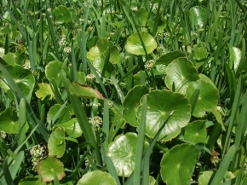 |
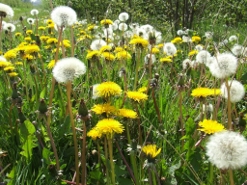 |
New weeds get introduced into your lawn in various ways every day. A large number of weeds are designed to be spread by gusts of wind. Some weeds can also be spread by water carrying them onto your lawn during heavy rains. People and animals play a part in spreading weeds. Sandspurs, beggar weeds and many other types of weeds are designed to stick to you or your pets as they walk past them. Bird seed can contain a variety of weeds. New sod or grass seed will also have its share of weeds in it. Even after successfully treating and eliminating a weed, there is a possibility that it has already reseeded itself for next year. So you can see that there is no way to have a weed free lawn, unless you are willing to pull weeds every single day.
Once weeds start to grow in your lawn, they can be very hard to get rid of. Dollar weed is especially difficult to control once it has started growing in your lawn. If you have tried pulling them, then you know that if you pull one, there are usually 5 more connected to it. Other weeds may be rooted so deep that it makes pulling them very difficult. Thankfully you are not alone in the fight to control weeds, when you have a monthly lawn treatment plan set up.
Weeds germinate year around, so why not kill them year around? With most herbicides, treating during the heat of summer will cause the surrounding grass to die. Treating in high temperatures can also cause stress on your grass. This takes a while for the grass to recover from. Year around weed control is counter-productive. Winter and other cooler months, are the best times to do weed treatment.
Shrubbery and Foliage Insects
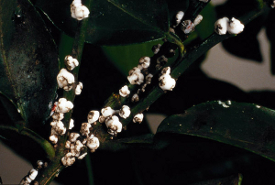 |
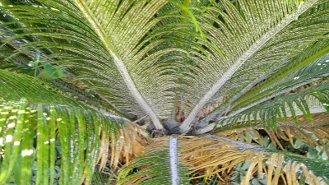 |
Various species of tress and shrubbery are susceptible to different kinds of scale insects. As shown above, your tree or shrub will appear to turn white when covered by scale insects. Scale are so named because of the waxy covering they secrete over their bodies that resemble fish scales. By feeding on the sap circulating inside their host plant, Scale are essentially parasites. Scale insects will eventually kill the plant that they are feeding on.
Sometimes your shrubbery may turn black. This is from a substance called black sooty mold, which is indirectly caused by scale insects. Black sooty mold is a fungus that grows where ever there are sugary secretions from aphids or scale. When left unattended it will turn shrubs completely black.
Aphids, much like scale, feed on the sap of a plant. The feeding process greatly damages the plant, by removing the plants sap. Their saliva is also toxic to plants. The highest concentration of Aphids can be found on the “new growth” of plants. There are many different species of Aphids, and all will damage and eventually kill the plants they are feeding on if left untreated.
Our Lawn program can control all of these problems and more, at your convenience with monthly, bi-monthy, quarterly or one-time service.
Licensed, Bonded and Insured
Serving St. John’s County and surrounding areas

